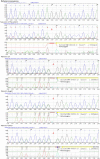A novel SLC12A3 homozygous c2039delG mutation in Gitelman syndrome with hypocalcemia
- PMID: 30558554
- PMCID: PMC6296056
- DOI: 10.1186/s12882-018-1163-3
A novel SLC12A3 homozygous c2039delG mutation in Gitelman syndrome with hypocalcemia
Abstract
Background: Gitelman syndrome (GS) is a rare autosomal recessive renal tubular disease, caused by mutations in the SLC12A3 gene, which encodes the renal thiazide-sensitive Na/Cl cotransporter (NCCT) in the distal renal tubule.
Case presentation: A 23-year-old woman was admitted with limb numbness, recurrent tetany and palpitation. Laboratory tests showed hypokalemic alkalosis, hypomagnesemia, hypocalcemia and secondary hyperaldosteronism, as well as hypocalciuria and transient decreased PTH. Next-generation sequencing detected a novel homozygous mutations c.2039delG in the SLC12A3 gene, and her father and children were all heterozygous carriers.
Conclusion: We reported a case of GS with a novel homozygous frame-shift mutation of SLC12A3, and reviewed recent literatures about diagnosis, differential diagnosis and treatments. Hypocalcemia in Gitelman syndrome is rare, and may be related to inhibited PTH secretion induced by hypomagnesemia.
Keywords: Gitelman syndrome; Hypocalcemia; SLC12A3 gene mutation.
Conflict of interest statement
Ethics approval and consent to participate
No ethical approval was required for this case report. Written informed consent was obtained from all individual participants or the guardians (if under age of 18) included in the study.
Consent for publication
Written informed consent was obtained from all individuals who participated to publish the details in this case.
Competing interests
The authors declare that they have no competing interests.
Publisher’s Note
Springer Nature remains neutral with regard to jurisdictional claims in published maps and institutional affiliations.
Figures


Similar articles
-
A novel compound heterozygous variant of the SLC12A3 gene in Gitelman syndrome pedigree.BMC Med Genet. 2018 Jan 29;19(1):17. doi: 10.1186/s12881-018-0527-7. BMC Med Genet. 2018. PMID: 29378538 Free PMC article.
-
A novel homozygous SLC12A3 mutation causing Gitelman syndrome with co-existent autoimmune thyroiditis: a case report and review of the literature.CEN Case Rep. 2024 Oct;13(5):330-338. doi: 10.1007/s13730-023-00845-z. Epub 2024 Feb 3. CEN Case Rep. 2024. PMID: 38308744 Free PMC article. Review.
-
A NOVEL COMPOUND HETEROZYGOUS VARIANT OF SLC12A3 GENE IN A PEDIGREE WITH GITELMAN SYNDROME CO-EXISTENT WITH THYROID DYSFUNCTION.Endocr Pract. 2018 Oct 2;24(10):889-893. doi: 10.4158/EP-2018-0218. Epub 2018 Aug 7. Endocr Pract. 2018. PMID: 30084681
-
A novel compound heterozygous variant of the SLC12A3 gene in Gitelman syndrome with diabetes and the choices of the appropriate hypoglycemic drugs: a case report.BMC Med Genomics. 2021 Aug 4;14(1):198. doi: 10.1186/s12920-021-01047-1. BMC Med Genomics. 2021. PMID: 34348722 Free PMC article.
-
A novel SLC12A3 gene homozygous mutation of Gitelman syndrome in an Asian pedigree and literature review.J Endocrinol Invest. 2016 Mar;39(3):333-40. doi: 10.1007/s40618-015-0371-y. Epub 2015 Aug 11. J Endocrinol Invest. 2016. PMID: 26260218 Review.
Cited by
-
Novel heterozygous missense mutation of SLC12A3 gene in Gitelman syndrome: A case report.World J Clin Cases. 2019 Jun 26;7(12):1522-1528. doi: 10.12998/wjcc.v7.i12.1522. World J Clin Cases. 2019. PMID: 31363482 Free PMC article.
-
Gitelman syndrome: A case report.World J Clin Cases. 2022 Jun 16;10(17):5893-5898. doi: 10.12998/wjcc.v10.i17.5893. World J Clin Cases. 2022. PMID: 35979117 Free PMC article.
-
A novel mutation of SLC12A3 gene causing Gitelman syndrome.SAGE Open Med Case Rep. 2022 Jun 7;10:2050313X221102294. doi: 10.1177/2050313X221102294. eCollection 2022. SAGE Open Med Case Rep. 2022. PMID: 35693921 Free PMC article.
-
Gitelman Syndrome and Hypertension: A Case Report.Cureus. 2023 Sep 2;15(9):e44590. doi: 10.7759/cureus.44590. eCollection 2023 Sep. Cureus. 2023. PMID: 37795074 Free PMC article.
References
-
- Gitelman HJ, Graham JB. Welt LG. A new familial disorder characterized by hypokalemia and hypomagnesemia. Trans Assoc Am Phys. 1966;79:221–235. - PubMed
-
- Zhang L, Zhang J, Yang J, et al. PriVar: a toolkit for prioritizing SNVs and indels from next-generation sequencing data. Bioinformatics. 2013;29(1):124–125. - PubMed
-
- Parmar MS, Bhimji SS. Gitelman Syndrome. 2017.
-
- Blanchard A, Bockenhauer D, Bolignano D, et al. Gitelman syndrome: consensus and guidance from a kidney disease: improving global outcomes (KDIGO) controversies conference. Kidney Int. 2017;91(1):24–33. - PubMed
Publication types
MeSH terms
Substances
LinkOut - more resources
Full Text Sources

